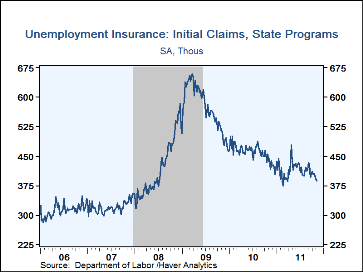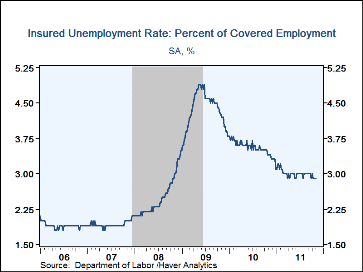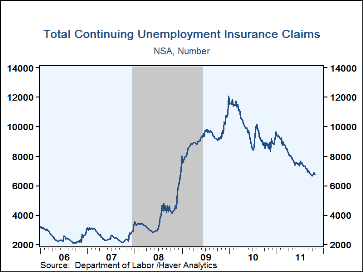 Global| Nov 17 2011
Global| Nov 17 2011U.S. Initial Claims For Jobless Insurance Fall To New Low
by:Tom Moeller
|in:Economy in Brief
Summary
Initial claims for jobless insurance fell last week to 388,000 from 393,000 (revised from 390,000) during the week prior. The latest figure was the lowest since the first week of April and compared to 395,000 expected in the Action [...]
Initial claims for jobless insurance fell last week to 388,000 from 393,000 (revised from 390,000) during the week prior. The latest figure was the lowest since the first week of April and compared to 395,000 expected in the Action Economics survey. The 4-week moving average of claims fell to 396,750, also its lowest since April. During the last ten years there has been a 75% correlation between the level of claims and the m/m change in payroll employment.
Continuing claims for unemployment insurance fell to 3.608M in the November 5th week, again their lowest of the economic recovery. The insured unemployment rate held at 2.9% for the fourth straight. By state, the rate varied as of October 29th with Virginia (1.4%), New Hampshire (1.6%), Texas (1.7%), Minnesota (1.8%), Indiana (1.9%), Tennessee (2.0%) and Florida (2.0%) at the low end of the range. At the high end were rates in Illinois (3.0%), South Carolina (3.1%), Connecticut (3.1%), Nevada (3.2%), New Jersey (3.4%), California (3.5%) and Pennsylvania (3.5%).
The grand total of those receiving unemployment insurance, including extended programs run by the states and the federal government, was 6.773M (-23.5% y/y) as of October 29th. Regular extended benefits, with eligibility dependent on conditions in individual states, fell to 523,772 (-45.8% y/y) and those on the special "EUC 2008" programs fell to 2.935M (-25.9% y/y).
Data on weekly unemployment insurance programs are contained in Haver's WEEKLY database, including the seasonal factor series, and they are summarized monthly in USECON. Data for individual states, including the unemployment rates that determine individual state eligibility for the extended benefits programs and specific "tiers" of the emergency program, are in REGIONW, a database of weekly data for states and various regional divisions. Action Economics estimates are in AS1REPNA.
| Unemployment Insurance (000s) | 11/12/11 | 11/5/11 | 10/29/11 | Y/Y% | 2010 | 2009 | 2008 |
|---|---|---|---|---|---|---|---|
| Initial Claims | 388 | 393 | 400 | -12.0 | 461 | 577 | 413 |
| Continuing Claims | -- | 3,608 | 3,665 | -15.5 | 4,544 | 5,807 | 3,338 |
| Insured Unemployment Rate(%) | -- | 2.9 | 2.9 | 3.4 (11/10) |
3.6 | 4.4 | 2.5 |
| Total "All Programs" (NSA) | -- | -- | 6.773M | -23.5 | 9.850M | 9.163M | 3.903M |
Tom Moeller
AuthorMore in Author Profile »Prior to joining Haver Analytics in 2000, Mr. Moeller worked as the Economist at Chancellor Capital Management from 1985 to 1999. There, he developed comprehensive economic forecasts and interpreted economic data for equity and fixed income portfolio managers. Also at Chancellor, Mr. Moeller worked as an equity analyst and was responsible for researching and rating companies in the economically sensitive automobile and housing industries for investment in Chancellor’s equity portfolio. Prior to joining Chancellor, Mr. Moeller was an Economist at Citibank from 1979 to 1984. He also analyzed pricing behavior in the metals industry for the Council on Wage and Price Stability in Washington, D.C. In 1999, Mr. Moeller received the award for most accurate forecast from the Forecasters' Club of New York. From 1990 to 1992 he was President of the New York Association for Business Economists. Mr. Moeller earned an M.B.A. in Finance from Fordham University, where he graduated in 1987. He holds a Bachelor of Arts in Economics from George Washington University.










